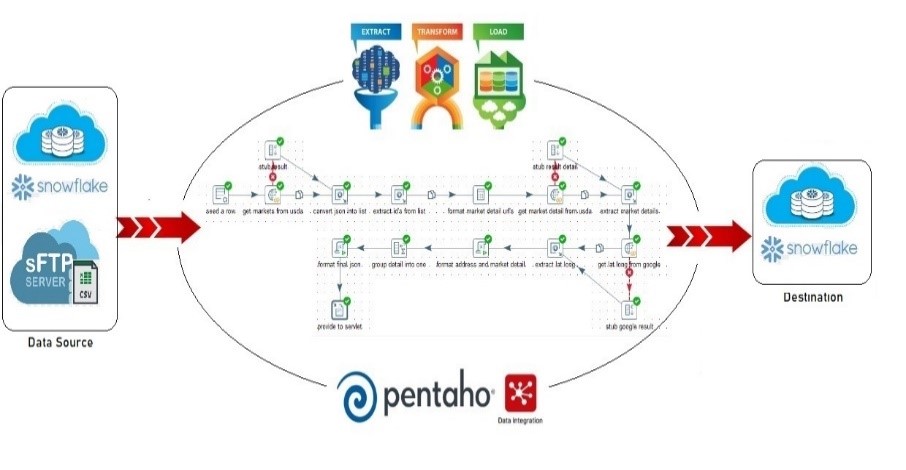
Problem Statement:
The client faced difficulties managing and analyzing large data volumes stored in CSV files on sftp server and a third-party Snowflake source, which resulted in slow processing and limited reporting capabilities. To overcome these challenges, they aimed to modernize their data infrastructure by optimizing storage, streamlining workflows, and enabling real-time analytics to support faster, data-driven decision-making.
Solution Overview:
To address the client’s challenges with managing and processing data by ingesting CSV files from sftp server and a third-party Snowflake source, a comprehensive solution was implemented with robust error handling and notification features:
- Data Ingestion:
Automated Pipelines: Developed automated pipelines in Pentaho to ingest data from both CSV files and the third-party Snowflake source. This streamlined data collection and ensured consistent data flow. - Data Processing and Transformation:
Pentaho Capabilities: Leveraged Pentaho’s powerful data transformation tools to clean, process, and transform the ingested data. This ensured the data was properly formatted and structured for downstream analytics. - Data Loading:
Target Snowflake Warehouse: The processed data was loaded into the client’s Snowflake warehouse, providing a centralized and scalable environment for data storage and management. - Automation:
Incremental Data Processing: Automated workflows and pipelines were configured for incremental data ingestion and processing, enabling efficient handling of ongoing data updates without manual intervention. - Error Handling and Notifications:
SMTP Configuration: Configured SMTP for email notifications, enabling the system to automatically trigger alerts to specific users upon the success or failure of pipelines. This ensured that any issues were promptly addressed, and the status of data workflows was transparently communicated to stakeholders. - Power BI Dashboards:
Visualization: Built interactive Power BI dashboards by connecting directly to the client’s Snowflake warehouse. This enabled real-time or near-real-time reporting, providing stakeholders with actionable insights and facilitating data-driven decision-making across the organization.
This solution not only enhanced the client’s data management and analytics capabilities but also ensured that the entire process was resilient, with built-in mechanisms for error detection and user notifications.
Tech Stack Leveraged:
Pentaho: Used for automating data ingestion, processing, and transformation workflows.
Snowflake: Data warehouse used for storing the processed data and serving as the central repository for analytics.
Power BI: Business intelligence tool used to create interactive dashboards and reports by connecting to the Snowflake warehouse.
SFTP: Used for securely storing and accessing source CSV files.
Benefits Delivered:
Here are some key benefits delivered by the implemented solution:
- Enhanced Data Accessibility: Streamlined data ingestion from diverse sources (CSV and Snowflake) into a centralized Snowflake warehouse, making data readily accessible for analysis.
- Improved Data Processing Efficiency:
Leveraged Pentaho’s transformation capabilities to automate data processing workflows, significantly reducing manual effort and processing time. - Real-Time Analytics and Reporting:
Enabled real-time or near-real-time data reporting by integrating Power BI with the Snowflake warehouse, empowering stakeholders with up-to-date insights. - Scalability and Flexibility: The solution is scalable, allowing for the easy addition of new data sources and handling of increasing data volumes without performance degradation.
- Automation and Reduced Human Error: Automated workflows for incremental data ingestion and processing minimized the risk of human error and ensured consistent data quality.
- Proactive Error Handling: Configured automated email notifications via SMTP to alert users of pipeline successes and failures, ensuring timely intervention and continuous data pipeline monitoring.
- Cost and Time Savings: By automating data workflows and enhancing processing speed, the solution reduced operational costs and freed up resources for more strategic tasks.
- Facilitated Data-Driven Decision Making: The Power BI dashboards provided a user-friendly interface for exploring data, allowing teams across the organization to make informed decisions quickly.





